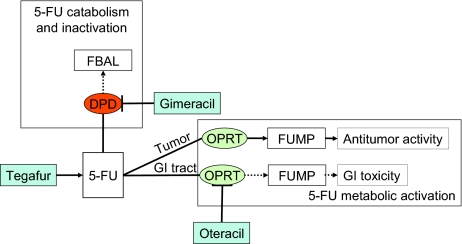Figure 2.
Schematic illustration of 5-FU metabolism and pharmacodynamic rationale for S-1. There are two competing routes of metabolism of 5-FU. Anabolic metabolism results in the active metabolites allowing the fluoropyrimidines to exert their therapeutic effect, whereas the dominant catabolic metabolism leads to inactive metabolites and the elimination of the drug. Anabolism of 5-FU to FUMP is catalyzed by OPRT. FUMP is subsequently metabolized to a series of products including FdUMP, which is ultimately the cytotoxic metabolite. Oteracil is intended to inhibit anabolism of 5-FU to FUMP by OPRT. In preclinical models, oteracil distributed into normal GI tract tissues to a larger extent than tumor cells and was associated with less 5-FU toxicity to GI tract tissues. Catabolism of 5-FU to 5,6 dihydro-5-FU, FUPA, and FBAL is principally mediated by the enzyme DPD. Gimeracil is intended to inhibit the catabolism and subsequent inactivation of 5-FU by reversibly inhibiting DPD, so that higher plasma concentrations of 5-FU could be achieved with the administration of a lower dose of tegafur.
Abbreviations: 5-FU, 5-fluorouracil; DPD, dihydropyrimidine dehydrogenase; FBAL, α-fluoro-β-alanine; FdUMP, 5-fluoro-2′-deoxyuridine monophosphate; FUMP, 5-fluorouridine-5′-monophosphate; FUPA, α fluoro β ureidopropionate; GI, gastrointestinal; OPRT, orotate phosphoribosyl transferase.

